Landscape composition: subject direction and main environment
So far in this series I've talked about compositional elements, their weights, and how to use their properties to balance your composition by imagining a balance of pairs around an image's central axis. I also talked about balancing negative space. But all this still does not give us a complete picture of the factors that should influence the compositional set-up. Today I want to talk about another placement consideration that has a big impact on my compositions: the lead room .
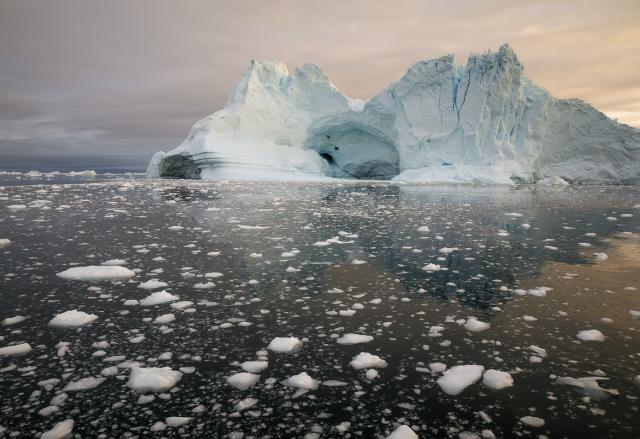 Is this iceberg "pointing" in any direction? What is it about its properties or shape that makes you think so? How and why did this consideration make me place the iceberg where I did? (Canon 5D4, Tamron 24-70mm F2.8, 1/500 sec, F8, ISO800)
Is this iceberg "pointing" in any direction? What is it about its properties or shape that makes you think so? How and why did this consideration make me place the iceberg where I did? (Canon 5D4, Tamron 24-70mm F2.8, 1/500 sec, F8, ISO800)
The main scene ( lead room ) is the space in the direction a subject is facing. It is mainly used in portrait photography, but I think it is extremely useful in landscape photography as well. That said, while in portraiture it is clear where this direction is, sometimes it is not so for non-living elements.
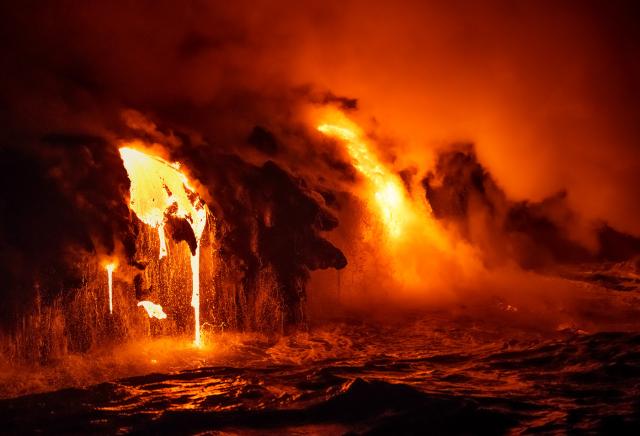 I hope you agree with me that the lava is "facing" to the right. (Canon 5D4, Canon 70-300mm F4-5.6, 1/250 sec, F5, ISO6400)
I hope you agree with me that the lava is "facing" to the right. (Canon 5D4, Canon 70-300mm F4-5.6, 1/250 sec, F5, ISO6400)
Just like in portrait photography, the human eye wants to know what's happening in the direction the subject is facing. The lack of space in that direction can therefore make the composition feel tense and unbalanced. It's exactly the same with landscapes: when a subject appears to be facing in one direction, we usually need to give it more space in that direction.
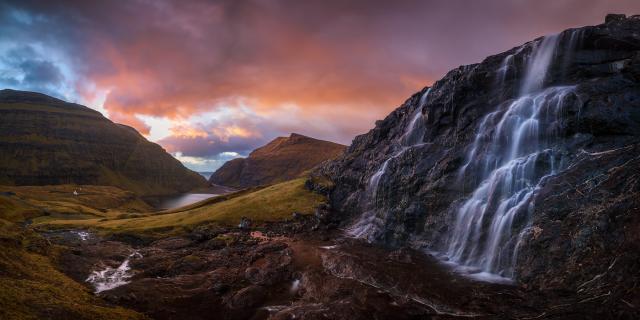 The main mass of this composition - the waterfall to the right - clearly faces to the left. And so I gave it a lot of leading space to the left and almost no space to the right. This works in conjunction with the main lines in the image. (Canon 5D4, Canon 16-35mm F4L IS, 3.2sec, F8, ISO200)
The main mass of this composition - the waterfall to the right - clearly faces to the left. And so I gave it a lot of leading space to the left and almost no space to the right. This works in conjunction with the main lines in the image. (Canon 5D4, Canon 16-35mm F4L IS, 3.2sec, F8, ISO200)
It will be helpful to look at several examples to better illustrate the use of negative space and subject position in the context of the lead room. Let's take a look at the two images below, both from Riisitunturi National Park, Finnish Lapland.
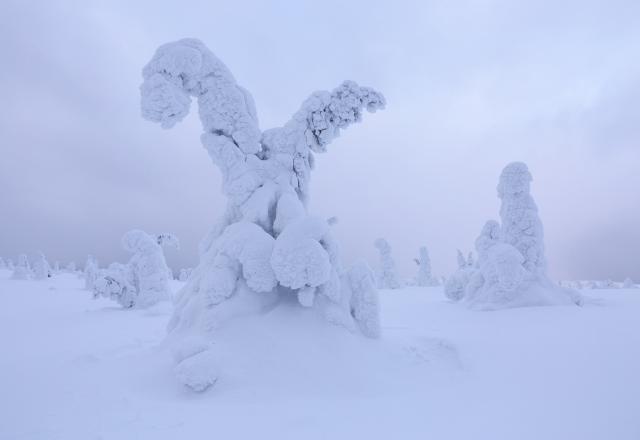
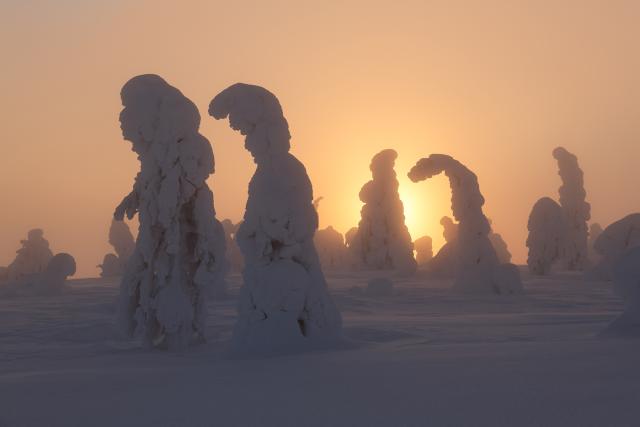
The first image has several masses, the heaviest being the rabbit-shaped tree on the left, and another tree on the right serves as an additional mass. The rabbit is clearly facing right (do you agree? What made me think?), and therefore needs more space in that direction, and the rightmost mass is (maybe not so clearly) facing left, and so it needs space in that direction. Both requirements are met, so the picture looks balanced in this respect.
In the second picture the situation is different. The main mass - the two trees to the left that look like contemplating wizards - faces to the left, but there isn't enough room in that direction, especially when compared to the space it has to the right. This causes the composition to be more tense and less serene. I don't think that's necessarily a bad thing in this specific case, since the background subjects help tell a story here, and the tension contributes to that. It is up to the photographer to know when to use this type of tension (a key notion in many photographic techniques). It is my personal feeling that images like the first seem self-contained, while images like the second seem to draw the viewer's attention out of the picture.
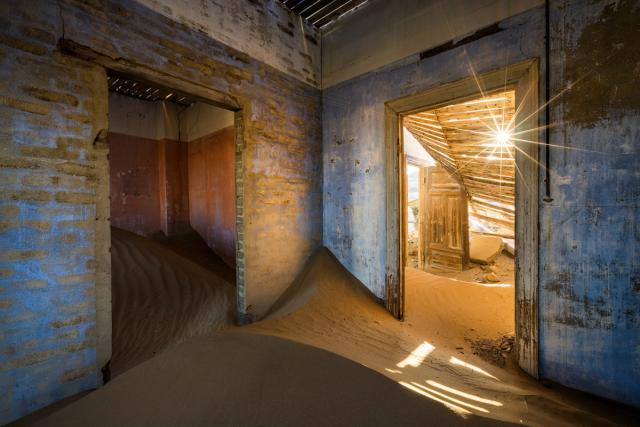 Compositional elements facing each other. (Sony A7R, Canon 16-35mm)
Compositional elements facing each other. (Sony A7R, Canon 16-35mm)
Determine which direction a subject is facing
So far I have relied mostly on intuition to tell which direction the masses are going. I'd say the direction of the subject is clear in the vast majority of cases, but there are some rules of thumb (based on feeling) to help you establish it if you can't see it immediately.
First, and most commonly used, when one side of the subject is further away from the viewer than the other, the subject can be seen facing in the direction of the far side.
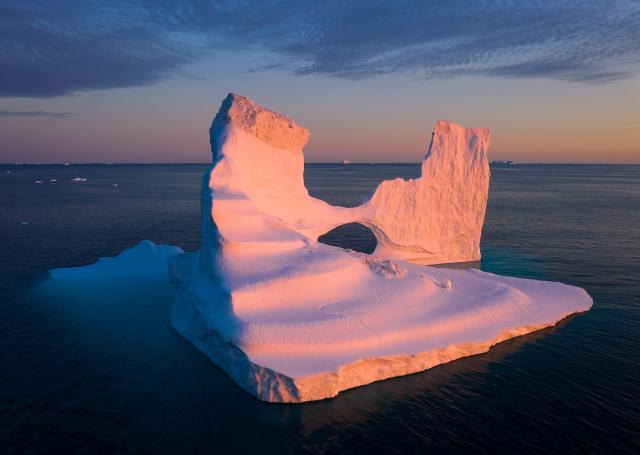 The left tower of this iceberg is closer to the viewer than the right tower. The iceberg as a whole therefore appears to be facing to the right. By the way, was I right not to give it much space on the right despite what is written in this article? How do you think I would justify it? (DJI Mavic II Pro, F8, 1/30 sec, ISO100)
The left tower of this iceberg is closer to the viewer than the right tower. The iceberg as a whole therefore appears to be facing to the right. By the way, was I right not to give it much space on the right despite what is written in this article? How do you think I would justify it? (DJI Mavic II Pro, F8, 1/30 sec, ISO100)
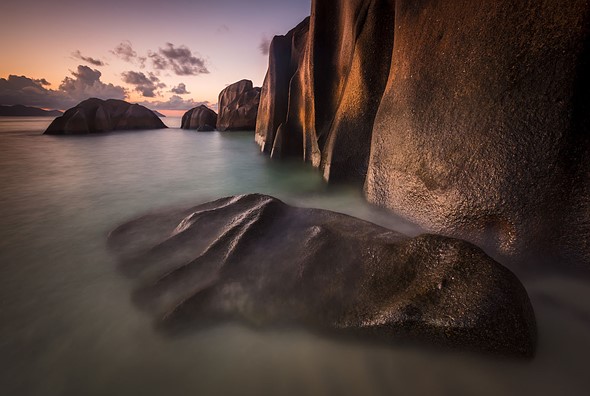 Both the foreground subject and the granite wall on the right have their right side closest to the viewer and therefore face left. (Canon 5D3, Canon 16-35mm F2.8, 20sec, F13, ISO400)
Both the foreground subject and the granite wall on the right have their right side closest to the viewer and therefore face left. (Canon 5D3, Canon 16-35mm F2.8, 20sec, F13, ISO400)
Another rule of thumb is that when one side of the subject is lower than the other, it can appear to be facing in the direction of that lower side. This is deeply psychological and arises from the fact that distant objects appear smaller than nearby ones, and thus the brain can be tricked into inferring that the lower part is further away.
The two guidelines mentioned above can and often do collide, and it is left to personal feeling which prevails.
 The left side of this iceberg is slightly lower than the right side, and so the iceberg appears to be pointing to the left, even though its left side was actually closer to me.
The left side of this iceberg is slightly lower than the right side, and so the iceberg appears to be pointing to the left, even though its left side was actually closer to me.
It is very pleasing to the eye to have different subjects facing each other in a landscape image. The resulting balance serves to make the composition peaceful and autonomous, and often has a good narrative factor.
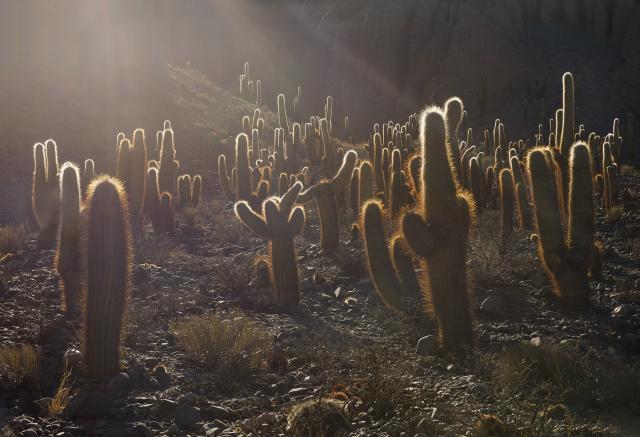 To me the mass composed of the various cacti on the left seems to face right, and the mass composed of cacti on the right seems to face left (do you understand why? Do you also agree?). The two masses facing each other make this composition much better. What other aspects that we haven't discussed yet make this composition work well? Tip: How do lines connecting foreground subjects interact with other lines in the image? (Canon 5D4, Tamron 24-70mm F2.8, 1/125 sec, F14, ISO100)
To me the mass composed of the various cacti on the left seems to face right, and the mass composed of cacti on the right seems to face left (do you understand why? Do you also agree?). The two masses facing each other make this composition much better. What other aspects that we haven't discussed yet make this composition work well? Tip: How do lines connecting foreground subjects interact with other lines in the image? (Canon 5D4, Tamron 24-70mm F2.8, 1/125 sec, F14, ISO100)
The third rule of thumb to help determine where a subject appears to be facing is lighting: the masses appear to be facing in the direction from which they are most illuminated. Again, this makes perfect sense as illumination often comes from the direction of vision.
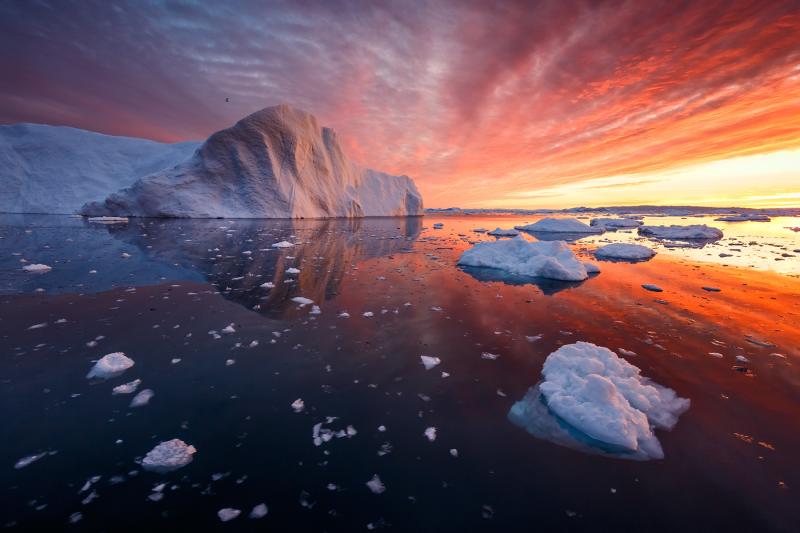 The right side of the background mass is lit from the right, so this is the direction it appears to be facing. What else about this image makes you feel like the iceberg is pointing to the right? (Canon 5D3, Canon 16-35mm F4L IS, 1/60 sec, F5.6, ISO400)
The right side of the background mass is lit from the right, so this is the direction it appears to be facing. What else about this image makes you feel like the iceberg is pointing to the right? (Canon 5D3, Canon 16-35mm F4L IS, 1/60 sec, F5.6, ISO400)
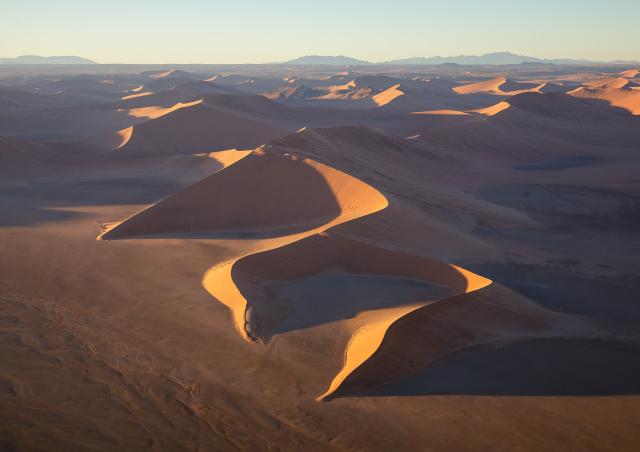 The forked dune below is lit from the left, so it appears to face left. This is also supported by its shape and the fact that its right side is closer to the viewer than the left. (Canon 5D4, Canon 24-105mm F4, 1/1000 sec, F8, ISO1600)
The forked dune below is lit from the left, so it appears to face left. This is also supported by its shape and the fact that its right side is closer to the viewer than the left. (Canon 5D4, Canon 24-105mm F4, 1/1000 sec, F8, ISO1600)
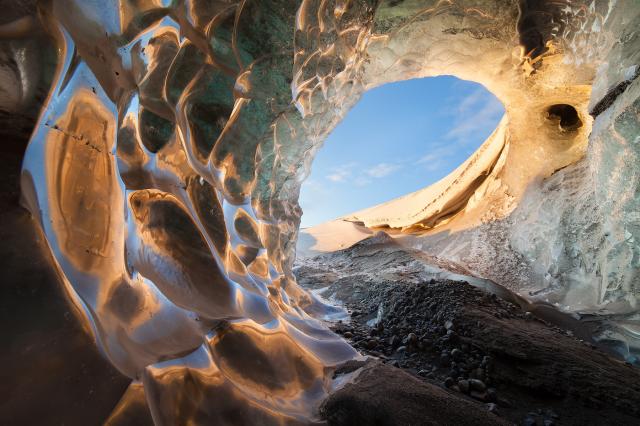 The light reflecting in the ice causes the right and left masses to be illuminated in a way that strengthens the perception of them facing each other (which was not exactly the case in reality). (Canon 5D2, Samyang 14mm F2.8, 1/25 sec, F14, ISO100, manual HDR processing)
The light reflecting in the ice causes the right and left masses to be illuminated in a way that strengthens the perception of them facing each other (which was not exactly the case in reality). (Canon 5D2, Samyang 14mm F2.8, 1/25 sec, F14, ISO100, manual HDR processing)
The last rule of thumb I'd like to talk about is guidelines . I haven't touched on lines since the first article, but they can play a crucial role in determining where a mass appears to be facing in a landscape shot. My intuition is that when lines emanate from a mass towards a specific direction, it reinforces the perception of the mass facing that same direction.
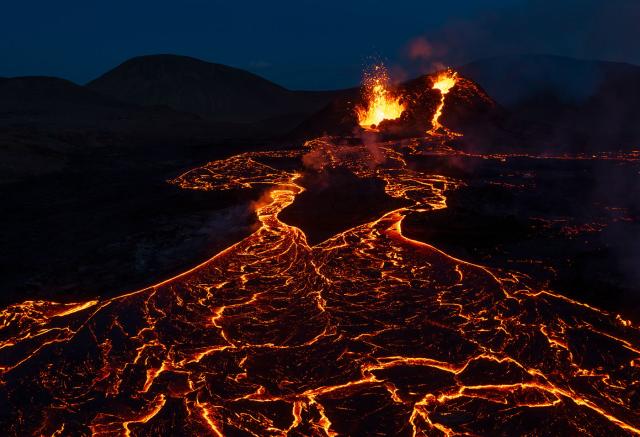 The volcanic fissure at upper right has its left side lower than its right side, and also has lines emanating from it running from right to left. Both of these properties reinforce the perception that it faces left.
The volcanic fissure at upper right has its left side lower than its right side, and also has lines emanating from it running from right to left. Both of these properties reinforce the perception that it faces left.
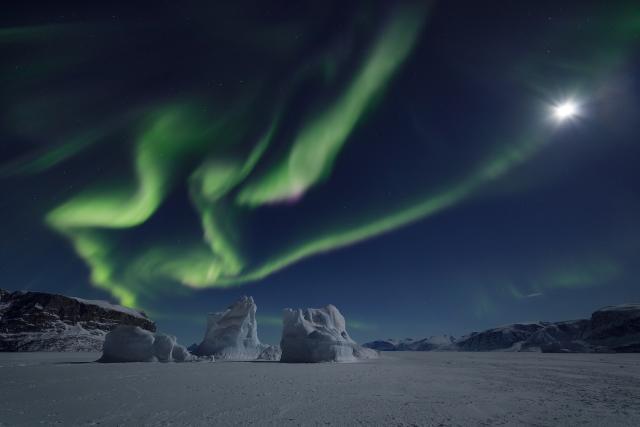 While this cluster of icebergs does not actually appear to be facing in a specific direction by itself, the lines of aurora borealis emanating from the icebergs to the right reinforce the perception of this right-facing mass. (Canon 5D4, Canon 11-24mm F4, 3.2sec, F4, ISO1600)
While this cluster of icebergs does not actually appear to be facing in a specific direction by itself, the lines of aurora borealis emanating from the icebergs to the right reinforce the perception of this right-facing mass. (Canon 5D4, Canon 11-24mm F4, 3.2sec, F4, ISO1600)
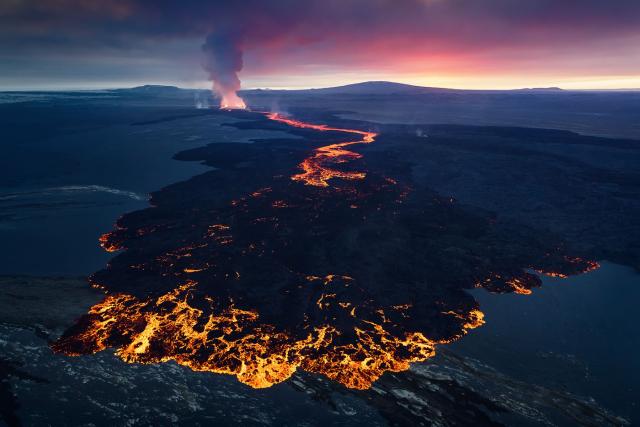 While it's really hard to make out any detail on the mass to the upper left (the fissure eruption), the river of lava flowing out of it and to the right makes it appear to be facing that direction. (Canon 5D2, Tamron 24-70mm F2.8, 1/200 sec, F4, ISO1600)
While it's really hard to make out any detail on the mass to the upper left (the fissure eruption), the river of lava flowing out of it and to the right makes it appear to be facing that direction. (Canon 5D2, Tamron 24-70mm F2.8, 1/200 sec, F4, ISO1600)
I would like to mention that proportionality is extremely important when deciding where to place a mass based on where it is facing. What I mean is that if a mass is only pointing slightly to the right, the resulting placement should be slightly to the left of what it would have been without the mass pointing anywhere, and vice versa: if the aspect is strong and emphasized, the effect should be considerable.
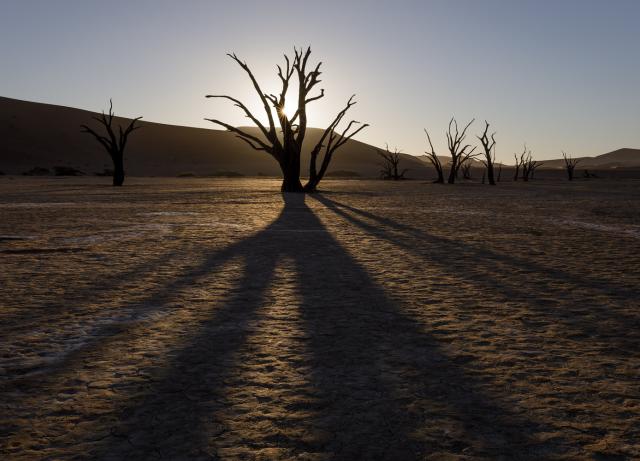 The shadow lines emanating from the central shaft are (on average) pointing slightly to the right. Without much further consideration of subject direction, I placed the tree slightly off-center to the left. (Canon 5D4, Canon 16-35mm F2.8, 1/100 sec, F16, ISO100)
The shadow lines emanating from the central shaft are (on average) pointing slightly to the right. Without much further consideration of subject direction, I placed the tree slightly off-center to the left. (Canon 5D4, Canon 16-35mm F2.8, 1/100 sec, F16, ISO100)
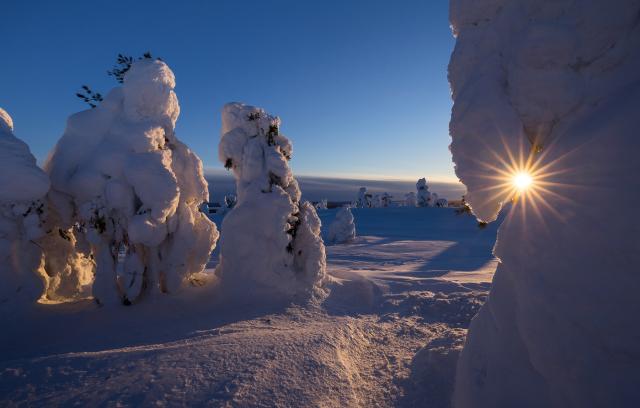 This tree and snow 'golem' on the left is very clearly and strongly pointed to the right (this is reinforced by the fact that it is lit from the right). This made me sit to the far left and give him a lot of lead room. (Sony A7R, Canon 16-35 F4L IS, 1/100 sec, F14, ISO100)
This tree and snow 'golem' on the left is very clearly and strongly pointed to the right (this is reinforced by the fact that it is lit from the right). This made me sit to the far left and give him a lot of lead room. (Sony A7R, Canon 16-35 F4L IS, 1/100 sec, F14, ISO100)
If the masses cannot be turned in any direction, at least not to the right or to the left. in this case, the main scene simply shouldn't be considered for placement.
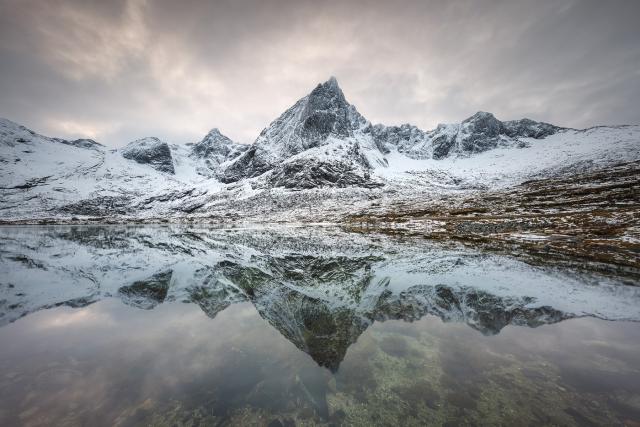 Mount Stortinden (centre) doesn't appear to be facing anywhere - I'd say its face points to the right and its slope to the left balance each other out. I had no other considerations and so I placed it in the center which made for a nice symmetrical composition without too much tension. The reflection adds to this by creating another axis of symmetry. (Canon 5d4, Canon 11-24mm F4, ISO100, 0.5sec, F11)
Mount Stortinden (centre) doesn't appear to be facing anywhere - I'd say its face points to the right and its slope to the left balance each other out. I had no other considerations and so I placed it in the center which made for a nice symmetrical composition without too much tension. The reflection adds to this by creating another axis of symmetry. (Canon 5d4, Canon 11-24mm F4, ISO100, 0.5sec, F11)
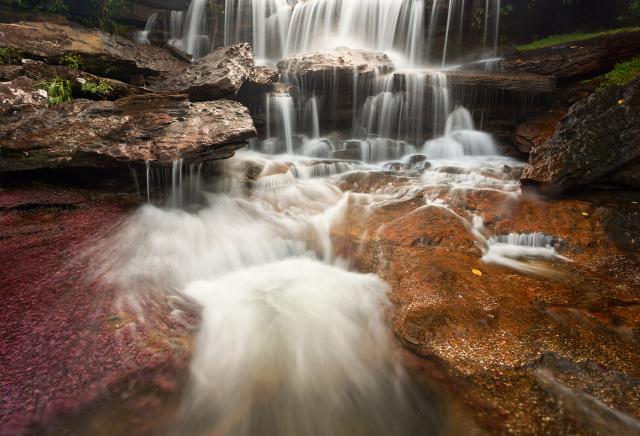 The upper waterfall faces no direction. The one on the left faces right. Both are placed accordingly in the composition. (Canon 5D3, Canon 17-40mm F4, F10, ISO100, HDR using 3 images)
The upper waterfall faces no direction. The one on the left faces right. Both are placed accordingly in the composition. (Canon 5D3, Canon 17-40mm F4, F10, ISO100, HDR using 3 images)
Finally, let's look at one last image.
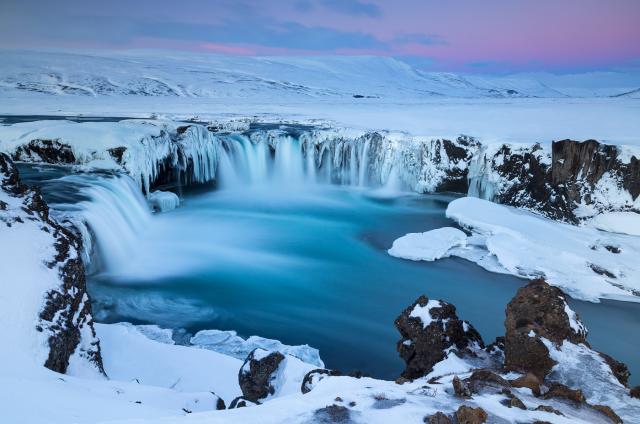 The snowy Goðafoss waterfall, Iceland Canon 5D3, Tamron 24-70mm F2.8, 30 sec, F13, ISO100
The snowy Goðafoss waterfall, Iceland Canon 5D3, Tamron 24-70mm F2.8, 30 sec, F13, ISO100
The main masses have a good edge in the direction they face. There is good negative space both top and bottom, left and right. The light is nice, the colors are quite good, and the long exposure helps reduce clutter and highlight important compositional elements. However, I have a big problem with this image. Can you see what it is? This problem will be the subject of my next article.
When you subscribe to the blog, we will send you an e-mail when there are new updates on the site so you wouldn't miss them.
By accepting you will be accessing a service provided by a third-party external to https://www.insightadv.it/


































































Comments